Information technology plays an increasingly prominent role in the strategic initiatives of higher education institutions. Technology projects are becoming the largest projects on campus, approaching funding levels of bricks and mortar investments.1 Information systems are viewed as critical in attracting high-quality faculty, staff, and students, and they are used to solve administrative information problems, support accreditation efforts, integrate curriculum, and deliver course content.2
All of this does not come cheaply. In fact, the cost of delivering IT services is rising steadily. According to the Fourth Annual EDUCAUSE Survey, IT funding is the number one IT-related challenge.3 The report states that four specific factors cause the cost of delivering IT services on university campuses to rise:
- increased demand for services,
- growing numbers of users,
- increased complexity of today's integrated systems, and
- rising expectations for superior customer service.
Many campus leaders believe that outsourcing selective IT operations is the answer.4
With the current economic environment putting pressure on state budgets, the efficient use of technology is becoming more important among institutions of higher education. Compounding the IT problem is the steady demand by an institution's constituents for state-of-the-art IT services. Despite the dot-com bust of a few years ago, there remains a shortfall of highly qualified IT personnel within academia. Universities can seldom match the salaries that the private sector pays, and it is difficult for IT specialists within a university environment to stay current with new technologies. According to a recent white paper,
This article briefly examines the information needs of higher education institutions, specifically the needs of business schools for data on faculty activities. We also explore outsourcing options using the University of Tennessee as an example. The specific project described here involved outsourcing a Web-enabled faculty database called SEDONA.
Information Needs
Managing faculty at a college of business requires the collection, aggregation, and dissemination of large amounts of data on faculty activities. The amount of information that business schools are required to maintain on their faculty has increased dramatically over the past 15 years. It is ironic that colleges of business, whose faculty teach business courses like management, accounting, and information systems, rarely have systems that readily support the data management of college faculty.
Much of the need for faculty information results from the increased number of schools and colleges of business that seek accreditation by the Association to Advance Collegiate Schools of Business (AACSB). Currently, there are 359 accredited programs in the United States.6 College deans and department heads also have an increasing demand for faculty information that might be unrelated, or at least tangential, to accreditation activities. Business schools regularly evaluate faculty to determine promotions and raises, for example. This determination is made by examining how productive an individual faculty member has been, which is based on the faculty member's research, service, and teaching activities, among other efforts. Pulling the relevant information together to support this determination can be quite a challenge.
Other requirements for a college of business's information system include coordinating teaching schedules and workloads, coordinating scheduling of activities across the college, advising students, tracking alumni, and satisfying ad hoc requests, with which the dean's office is routinely bombarded. Business schools also prefer to evaluate their faculty and programs by comparing what they do to what their peer institutions are doing. Although these tasks are common to most colleges of business, there is currently no integrated way to do all this.
The problem of readily available, consistent information is not a challenge restricted to colleges of business. Other colleges within a university system have similar information needs yet arguably might be worse off than business schools in their ability to offer a workable and affordable solution. Likewise, at the university level, many universities are looking for systems that could standardize the gathering of common sets of data across their various colleges. These data could be used to support decisions to allocate limited funds among the colleges, as well as decisions to tenure and promote faculty.
What is more, many universities belong to state university systems where, because of budgetary restrictions, there is mounting competition for state funds. Thus, state officials perceive a growing need for systems providing readily obtainable information that can be used to guide and help justify the allocation of state funds across several universities. To provide this accountability, some state officials are looking to build, purchase, or lease Web applications to aggregate information across their state systems of universities.
The Outsourcing Option
While the business community has readily adopted selective outsourcing as a way to leverage technology, higher education has historically been slower to adopt this strategy. Due to the aforementioned pressures, however, institutions of higher education are forced to consider outsourcing selected IT operations. As with a private company, if an outsourcing vendor can produce higher quality work, more quickly and cheaply than can the university, the operation should be considered for outsourcing. The term "outsourcing" is defined broadly here to include (along with services and operations) the leasing of application software developed by third parties and the leasing of space on a remote server to store local data.
Application service providers (ASPs) lease Internet-based environments for enterprise resource planning (ERP) systems, e-mail and directory services, and other Web application services. With the Internet as the backbone, a Web-enabled application can be accessed from school, from home, or from anywhere that has Internet access. Literally from anywhere in the world, data can be entered into a form in a Web page and submitted to populate a database on a remote server. Likewise, the database can be queried remotely according to search criteria specified by users located anywhere in the world. Web-based reports can be dynamically generated (online and in real time), reflecting the most current state of the database.
For some university applications, it might make sense to lease Web application software through an ASP. Such an arrangement would provide universities with ubiquitous access to sophisticated Web application technology at an affordable price. Web applications can be leased at a fraction of what it would cost to develop them in-house or to purchase a generic software package from a third party. Data can be maintained at a Web-hosting site where backups are made on a regular basis. Any software updates to the Web application would be immediately and seamlessly distributed to end users whenever the Web pages were served. What is more, hosting the application remotely would avoid associated hardware, software, and administrative costs at the local university. In other words, not only would the university not have to devote time and money to develop, test, and deploy a new application, the university would also not be responsible for serving the application or storing and providing backups for the data.
Candidate Application for IT Outsourcing
In April 2003 the AACSB approved new standards for reaccreditation. What immediately impacts schools up for reaccreditation under the new standards is that the accreditation maintenance cycle shortens from 10 years to 5 years, and an annual reporting requirement is added. Also, the on-campus visit of the accreditation team is shorter, and the teams themselves are smaller.
The new standards continue to emphasize mission and the processes that support continuous improvement. Included in these processes is the ability to determine the sufficiency of the faculty. Much of this sufficiency determination is data driven. Faculty sufficiency is determined by considering all significant faculty activities, including research, teaching, instructional development, non-degree education, faculty development activities, community service, institutional service, and service in professional organizations.
The AACSB maintains that the reporting function is not intended as an additional burden but rather is the culmination of a reporting process already in place and being used by the host school in its ongoing activities. Further, the information generated is expected to be already available and in the form in which it is developed and used within the school. The problem is that few colleges of business actually have an adequate database system in place to readily capture, store, aggregate, and disseminate this faculty information. Having such a database of current faculty information would have advantages for faculty, administrators, and accrediting organizations.
Faculty members are often frustrated by the amount of information they are asked to provide to their administrators each academic year. To compound the problem, faculty members are often asked to provide the same information on several different occasions, using different formats. The amount of time spent on providing and managing this information no doubt takes away from the time faculty have to spend on the activities on which they will be evaluated—teaching, service, and research activities. The advantage of such a database to faculty is that they would need to provide the desired information only once. Once the data are entered and stored, they can be modified and updated easily. Using Web technology with such a database application has the potential to dramatically improve the process of collecting faculty research, teaching, and service information, especially for those universities having geographically dispersed campuses and/or faculty.
A Web-enabled faculty database also provides several advantages to administrators. First, having such a system in place makes the collection of data for an AACSB visit more manageable. Second, such a system allows dynamic generation of up-to-date reports covering any period desired (such as the five-year period for AACSB review) and including any type of information considered important by the school, formatted in whatever way is most appropriate. Third, having such a database gives administrators access to the information they need to manage and evaluate faculty, such as an integrated mechanism for administering pay-for-performance programs or a post-tenure review process. And fourth, just having a process in place for collecting faculty information might be regarded favorably by members of an AACSB accreditation team, who are looking for in-place processes that readily support continuous improvement.
Finally, such a Web-enabled database of faculty information would provide advantages to accrediting organizations. As mentioned earlier, the new processes for AACSB reaccreditation include a reduction in both the number of days a visiting team is on campus and the number of members on the visiting team. A Web-based application for storing faculty data would enable the visiting team to do much of their work (especially regarding faculty sufficiency and mission support) before arriving on campus. This would allow them to focus their limited on-campus time to areas that really need their attention.
Piloting SEDONA at the University of Tennessee
In 2001, the University of Tennessee was chosen by the AACSB to be a pilot school for the proposed new AACSB accreditation standards. Administrators at the University of Tennessee determined that a need existed for a Web-enabled database application to help manage faculty research, service, and teaching activities, as well as to support the new standards for AACSB reaccreditation. Two options were available to administrators to obtain this capability:
- develop the application in-house, and serve the application/store the data locally, or
- outsource the development and lease the application and storage.
Although faculty database applications can provide school administrators the information they need in the form they desire, developing such applications can be very expensive in time and money. Although the need might be apparent, many universities may not be able to dedicate that much time and money for this purpose.
This was the case for the College of Business at the University of Tennessee. AACSB's reaccreditation process was scheduled to occur in less than a year, and there was no automated system in place that could readily provide faculty research, service, and teaching information that could be included in the accreditation report.
When the college of business was asked if it would be interested in piloting a prototype Web application that would gather, store, aggregate, and generate reports on faculty research, service, and teaching activities, college administrators agreed. The University of Northern Colorado also agreed to pilot the Web application, called SEDONA.
SEDONA
SEDONA is a self-service, Web-enabled database application for collecting, managing, evaluating, and reporting faculty teaching, research, and service activities. It is served by Atavia, a Web-hosting site in Atlanta, Georgia.
Over the past 15 years, the IT industry has seen a progressive trend toward self-service functionality.7 Self-service Web applications are Web applications whose information is updated and maintained by the "customers." A customer, in the case of a college of business, is defined as a faculty and/or staff member. This type of application offloads much of the responsibility for data entry and maintenance onto those most interested in the data being current and correct—the faculty. For a self-service application to successfully shift the responsibility for maintaining the database onto the faculty, the faculty must be adequately motivated. This motivation can be engendered using a carrot or a stick.
Motivating Self-Service
The University of Northern Colorado uses a carrot. Upon identifying 20 top journals that the college administration would like its faculty to target for publication, the university rewards faculty who publish in these top journals with $1,000 per publication. This money goes toward the published faculty member's research budget.
The University of Tennessee, on the other hand, uses the stick approach to motivation. With this technique, annual evaluations of the college of business faculty are based on whatever data is in the database at evaluation time. Faculty who want to get the best possible evaluations will make sure that the information in SEDONA is current and correct.
Regardless of the method used to motivate people, for self-service Web applications to succeed, those being relied upon to enter and update the data must be persuaded to get it done.
Data Privacy, Security, Integrity, and Ownership
All Web applications involve concerns about data privacy, security, integrity, and ownership. In order to access the SEDONA application, all users must be authenticated on the login page (http://www.sedona.bz/) by entering a valid user ID and password. To ensure both privacy and security, the entire SEDONA application (not just the login) is located on a secured server. To ensure data integrity, data is validated through a battery of form input controls and selection lists. Backups of the data are made daily by the hosting service, weekly by SEDONA, and at other appropriate times by the universities themselves.
Regarding ownership, data collected through the SEDONA application and stored on the hosting server remains the exclusive property of the university leasing the service—neither SEDONA nor Atavia has any ownership in or rights to the data. Because the database is in a format that can be downloaded in its entirety at any time by the leasing university, the university is free to create its own local interface for the database, as well as its own reports. To end the lease, a university would simply not renew the annual license agreement.
Leveraging University Systems
One weakness identified in the prototype was that teaching schedules had to be reentered into SEDONA even though this information was already captured by another system within the university. To remedy this situation, SEDONA specified the fields and the order of fields that would need to be dumped by the university system into a CSV (comma separated value) file format. Once these fields were properly downloaded, they could be uploaded directly into SEDONA. This process avoided rekeying the data and the associated errors.
Eventually, Web services will be specified so that SEDONA can communicate with any legacy university system. With these Web services in place, redundant data entry in SEDONA will be eliminated.
SEDONA has transformed the manual processes of collecting, aggregating, and reporting faculty data into a real-time, Web-enabled, self-service faculty information system.
Features of SEDONA
Using the Internet Explorer browser, faculty members and administrators can access SEDONA by typing in the Internet address for the Web application. Figure 1 shows the login screen. Here, users can enter SEDONA through one of three doors: college, department/program, or faculty. Additionally, prospective users can click on "Demo" and enter SEDONA through any of the three doors, viewing fictitious data for "State University."
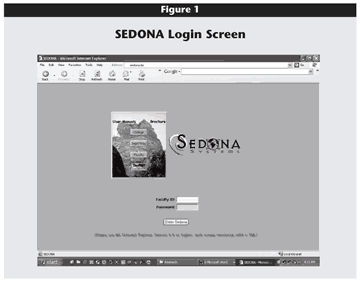
Click image for larger view.
To enter through the faculty door, a faculty member enters his or her faculty ID and password, and the system validates these against the database. Once validated, the faculty Navigator page is displayed (Figure 2), giving the faculty member access to and management of (add, edit, view, and delete) his or her records in the online database.
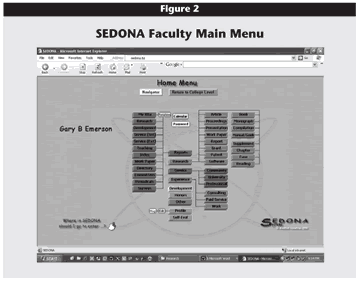
Click image for larger view.
On the Navigator page, a faculty member can access any part of the application with a single click. Shown on the right side of Figure 2 are links to various forms for entering data. Faculty can choose to enter information into their Profile, Research, Service, Experience, Development, Honors/Awards/Grants, or Other databases. In the lower left of this page is an icon (Where in SEDONA should I go to enter …?) that can be clicked to access online help. This help facility shows faculty where to enter various faculty activities and how to categorize the information consistently.
On the left side of the Navigator are the reports available to the individual faculty members. They also have access to a college-wide calendar, a frequently asked questions (FAQ) database, and an evaluation form. On this evaluation form, customized at the college level, faculty can indicate their goals and achievements. This information is used by the department for annual evaluations.
The most important report at the faculty level is the vita. The faculty vita is, like all the reports, dynamically populated from the underlying database whenever the page is served. This report allows the faculty data to be displayed in a standardized format (to permit simple comparisons between faculty as well as to aid administrators in finding data items), while the data in the report are dynamic. Also, faculty may customize their vitae, creating several templates through which to view various types of faculty information. Fonts, color, and size are all customizable. Faculty can enter information once into SEDONA, and their vitae are automatically generated from the database and can be downloaded as documents.
Clicking on Experience, Faculty Development, or Honor/Awards/Grants allows a faculty member to view, edit, or add data in these databases. Likewise, clicking on Service allows a faculty member to add, view, edit, or delete service information in Public, University, and Professional service categories.
Clicking Research allows a faculty member to add, view, edit, or delete intellectual contributions in the following categories: Article, Proceedings, Presentation, Working Paper, Research Report, Research Grant, Patent, Software, Book, Monograph, Compilation, Manual/Guide, Supplement, Chapter, Case, and Reading. The screen for managing articles is shown in Figure 3. This screen allows the faculty member to add, edit, or delete intellectual contribution records for articles. There are similar screens for the other components of intellectual contributions.
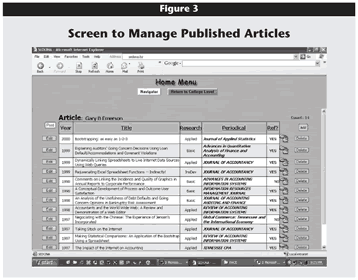
Click image for larger view.
Figure 4 shows the input screen for entering information on an article publication. Input screens for other areas of the database look similar. Here, faculty enter the title, status (accepted, published), research type (basic, applied, instructional development, other), mission code (determined by the university), periodical, reference information, and author information.
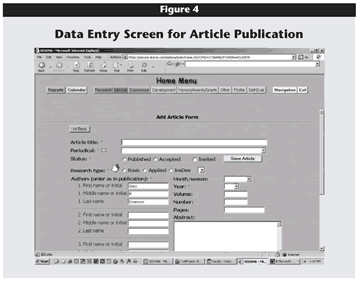
Click image for larger view.
On the periodical field is a drop-down list of periodicals.8 Including such a list means the coding for articles in these journals as peer reviewed or non-peer reviewed can be done automatically, providing consistency of data input. Also, top journals in a particular business area can be determined, and publications in these top journals can be tracked. Thus, the research history of a faculty member, a department, and the college as a whole can be weighted, ranked, and assessed. For example, Hasselback provided a ranked and weighted list of the top 40 journals in accounting.9 Similar lists can be compiled for the other business areas.
The work of committees within the departments and the college is very important to the goal of continuous improvement. Likewise, the documentation of such committee work would be critical to any accreditation process. The Committees report allows a faculty member to select a committee and then to view the members of the committee, the mission, the timeline, and the meeting minutes. Minutes are searchable by key words.
In addition to the screens available to individual faculty to support the documentation of research, service, and teaching activities, two administrator levels can be accessed with the proper ID and password at the login screen—department/program level and college level. Figure 5 shows the home page at the college level.
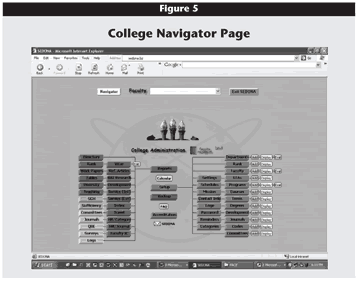
Click image for larger view.
As seen on the right side of Figure 5, administrators can set up Departments, Areas (within departments), Faculty (members and passwords), Programs, Courses, Terms, Intellectual contributions categories, faculty Development categories, teaching Schedules, Mission, College Committees, and Journals. Once these are set up, faculty can begin entering data.
On the left side of Figure 5 are the available reports. These reports aggregate information across all college faculty. (At the department level, the reports aggregate information across the faculty within the department.) This capability is extremely useful for purposes of accreditation.
Reports available at the college and department levels within SEDONA follow:
- Vitae—Allows administrators to display and print vitae or other templates for a group of faculty. The edit feature lets administrators create and edit other templates to extract and present data for other purposes (such as pay-for-performance, annual reviews, and tenure/promotion evaluations).
- Refereed Articles—Lists faculty by department and counts the number of publications in refereed journals for the period selected. Calculates what percent of the faculty have been active in publishing during this period.
- Research—Aggregates intellectual contributions by department, research type (basic, applied, instructional development), and review type (refereed, non-refereed).
- Development—Counts faculty development activities by department and development type.
- Service (both internal and external)—Counts faculty service by department and service type (university, public, professional).
- Travel—Image map showing where faculty have presented papers or received training or other faculty development.
- Hit/Category—Shows each faculty member's publications by category (publication type, research type, and review type) weighted by the number of coauthors.
- Hit/Journal—Lists journals by the number of publications by the entire faculty in that journal.
- Faculty IC—Shows an AACSB-specified report of faculty intellectual contributions. Contributions are categorized by research type and review type.
- Directory—Lists faculty and e-mail addresses by department. Administrators can view faculty vitae using a standard format from here.
- Rank—Shows faculty by department and rank (professor, associate, assistant, visiting).
- Working Papers—Shows a list of working papers and their abstracts for all faculty members in the college.
- Tables—An administrative report showing which faculty have entered items into which tables in SEDONA.
- Teaching—Report, by department, showing Hours, Enrollment, Student Credit Hours (SCH), Evaluations, and GPA. Also shows detailed teaching schedules by department and faculty.
- SCH—AACSB-specified Student Credit Hours report by department and rank.
- Sufficiency—AACSB-specified faculty sufficiency report.
- Diversity—Report on racial and gender diversity.
- Committees—College-wide committees, members, timeline, and minutes.
- Journals—List of journals, along with acceptance rates and weightings.
- QBE—Query-by-example screen. A potential drawback to the system is that the number of reports seeded in the application is limited. A QBE function was integrated within the application to accommodate the various needs of users. This functionality gives users access to the fields in each table of the database, allowing them to access all data items in the database, along with the ability to create and save customized, drill-down reports.
- Surveys—Screen that gives administrators the ability to design Web-based surveys for assessment uses. Administrators may develop instruments consisting of Likert scale, discussion, short answers, check box, and selection list objects to survey department heads, faculty, alumni, or any other constituents of interest. For each person on an e-mail list (multiple lists can be maintained), the system sends an e-mail with an embedded link to the Web survey. As the surveys are completed, the database is updated with the responses, and SEDONA graphs the results—all in real time.
By clicking on Report, administrators can choose the period of time each report covers, as well as the type of faculty member to filter on (tenured, tenure track, non-tenure track, graduate teaching assistant, inactive, participating, and supporting).
Feedback on SEDONA
In the past few months, about 20 colleges of business have adopted SEDONA, including the University of Illinois, PACE University, City University of New York, Xavier University, Western Kentucky University, South Carolina State University, Arizona State University, the University of Alabama–Birmingham, and the University of Alaska–Fairbanks. Several other universities are in the process of evaluating SEDONA for adoption. And SEDONA is receiving good reviews. Jan Williams, dean of the College of Business at the University of Tennessee, had the following to say:
Bruce Behn, a tenured associate professor at the University of Tennessee, made these comments:
Joe Alexander, dean of the college of business at the University of Northern Colorado had this to say:
Users at other universities adopting SEDONA echo these comments. Colin Read, associate dean of the college of business, University of Alaska–Fairbanks made the following observations:
Extension to Other Colleges
Can an application like SEDONA be deployed in a non-business college? This possibility is currently being investigated by several universities, including the University of Tennessee, the University of Alaska–Fairbanks, and Western Kentucky University. As it turns out, faculty in non-business colleges do research in categories that are very similar to the research categories that colleges of business faculty use: Learning and Pedagogical Scholarship (instructional development research), Contributions to Practice (applied research), and Discipline-Based Scholarship (basic research).
Some customization might be needed for non-business colleges. For example, the structure of some reports will likely be different. However, because data are stored in the database as atomic data elements (fields), they can be aggregated, compiled, and presented in formats that administrators can specify. This feature is already embedded in SEDONA in the QBE reporting capability. Though the extent of any required customization is yet to be determined, it might be minimal.
Summary and Conclusion
According to the Fourth Annual EDUCAUSE Survey, faculty development, support, and training is listed as one of the top-ten most important areas to resolve for strategic success.10 With current Internet technology, Web-based applications can be developed that impact the way universities collect and manage data on their faculty. SEDONA is just one example of using this technology.
The key advantages to using Internet database technology to accomplish faculty data collection and management tasks include the following:
- Universities could lease a Web-enabled application at a fraction of what it would cost to develop, host, and maintain an application in-house or to purchase a generic software package from a third party. Data is maintained at the Web-hosting site, where backups are the responsibility of the host.
- Self-service Web applications address the most critical aspect of having a database—ensuring that the database is current and correct. Faculty can be motivated to take responsibility for keeping their own research, teaching, and service records up-to-date.
- Using the ubiquitous and familiar Web browser interface, Web applications take much of the uncertainty out of using a software package and enable faculty to document their research, service, and teaching activities from school, from home, or from anywhere in the world with Internet access.
- Reports from a Web-enabled database application will always reflect the latest information in the database because they are dynamically generated from the underlying database.
- If several universities choose to use the same ASP, summary information could be shared across universities, allowing benchmarking against schools believed to have exemplary programs. This tool will enable administrators to get a better feel for which areas need attention.
- Any software updates to the Web application would be immediately and seamlessly distributed to end users whenever the updated Web pages were served.
Web technology has the potential to dramatically improve the process of collecting and disseminating faculty research, teaching, and service information. Such technology would be especially helpful for those universities having geographically dispersed campuses and/or faculty.
